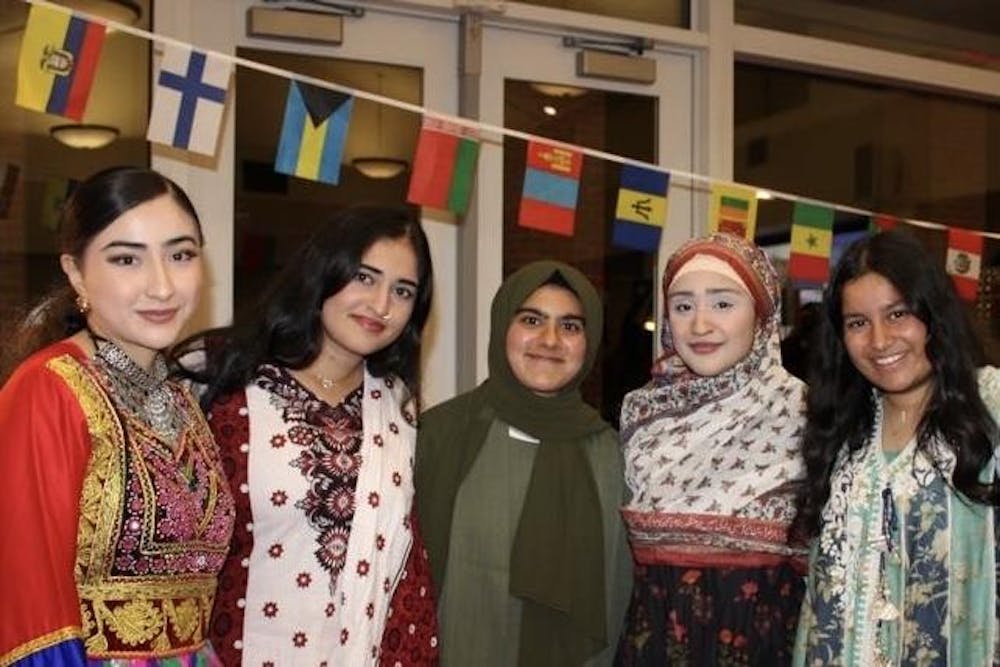The Muslim Students Association hosted its fourth annual Culture Showcase Saturday, inviting Muslim and non-Muslim students to dress in cultural attire and give brief presentations on their cultural roots. From explaining the history of their native countries to sharing pop culture references, students celebrated the similarities and diversity in their ethnic backgrounds.
Students enjoyed catering from Sultan Kebab while listening to their peers discuss their cultural heritage. The presentations featured countries such as Bangladesh, Egypt, India, Palestine, Sudan and more.
As presenters shared information about their countries’ transportation methods, cuisines and clothing, they encouraged listeners to see their cultural similarities rather than their differences. Fourth-year College student Nazifa Rahman, who gave a presentation on Bangladesh, said the gathering inspired a sense of unity among her and her peers.
“I think it's really important for us to come together collectively to strengthen our community, especially when there are so many similarities and overlaps within countries in the same continent,” Rahman said.
Fourth-year Batten student Aisha Amjad, who has attended the showcase every year of her time at the University, also noted how students bonded over shared elements of their heritage. She said the showcase gave students the opportunity to see the beauty, joy and connections within Muslim cultures.
“Culture can be such a big way of uniting people from diverse backgrounds because oftentimes … in the Muslim community, we have so many different points of tension that come up,” Amjad said. “But when you look at the culture, it’s so similar [among countries]. That’s what I love about a cultural showcase — you get to see the fun side.”
During their presentations, some students from Egypt shared pop culture references such as Tik Tok creator Faroukiie, who posts humorous videos about the household and social dynamics of Arab culture. Presenters expressed how Faroukiie’s content aims to be relatable to Muslims from cultures beyond Egypt.
Additionally, many students shared symbolic elements of their cultures. One student explained how Nepal’s flag — a non-rectangular flag made up of two triangular shapes — serves as both a visual portrayal of the country’s mountainous geography and a symbol of the two most commonly practiced religions in the country, Hinduism and Buddhism.
Meanwhile, students from Palestine spoke about the “key for return” — a symbol passed down through generations of families, representing the key to homes of their ancestors who were displaced during the Nakba of 1948. According to the students, the key represents the hope of one day returning to one’s ancestral homes.
Besides sharing cultural symbols, presenters explained how their identity has shaped their academic trajectories and involvements at the University. Amjad, who serves as Chair of the Diversity, Equity and Inclusion Committee in the Frank Batten School of Leadership and Public Policy, said her experiences as a cultural minority in her Batten cohort drove her to help increase representation within the academic program.
“When I first transferred into Batten, I felt a very profound sense of loneliness,” Amjad said. “I felt like there wasn't enough Muslim representation, especially because in my cohort, I was the only hijabi that I saw … I felt intimidated at first, but then I was like, I have to stay for representation … and I decided to apply to the DEI committee.”
Additionally, students spoke about the struggles that their native countries currently face or have faced in the past, such as Bangladesh’s fight in the 20th century to have Bengali recognized as an official language, the ongoing civil war in Sudan and the continuously disputed territory of Jammu and Kashmir between India and Pakistan. Rahman said presenting these conflicts inspired attendees to not only appreciate each other’s backgrounds but understand them in a global context.
“There's so many people here that share a different upbringing and different background, and it's a moment for us to reflect on how we grew up,” Rahman said. “It also [gives us] a deeper understanding that there are a lot of struggles lots of countries are going through. It’s really important for us to be aware of what's going on … so we can help in any way we can.”
As students shared a variety of cultural backgrounds, Ibrahim Ahmed, president of the MSA and fourth-year College student, said he hoped Muslim and non-Muslim attendees alike walked away from the event with a newfound appreciation for Muslim culture.
“[Some non-Muslim students] don't know what to expect when they come [to our events],” Ahmed said. “Leaving an impression is something that's really important, especially when it's their first impression.”
Students ended the night in cheerful discussion and celebration. As attendees mingled, took photos and enjoyed dessert, Rahman reflected on the elements of cultural heritage they had learned from each other.
“[The showcase] is a great way for us to come together as a collective,” Rahman said. “Even though it’s a five-minute presentation, you see the countries through a lens in the eyes of the people who very much cherish them, and that’s a beautiful aspect of the event.”







